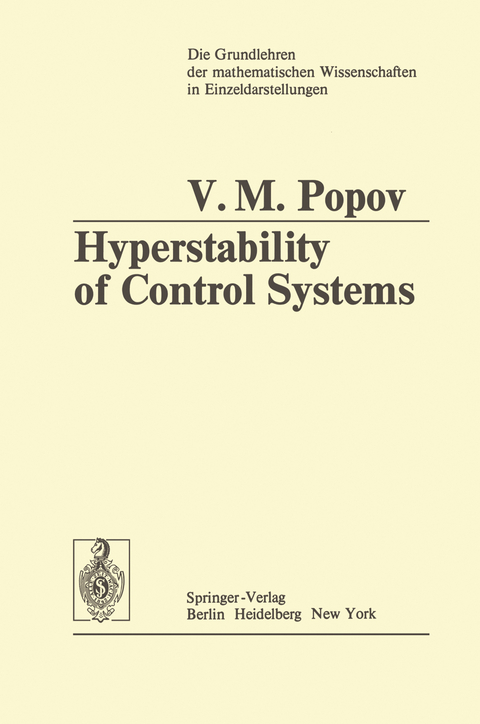
Hyperstability of Control Systems
Springer Berlin (Verlag)
978-3-642-65656-9 (ISBN)
1. Introduction.- 1. Stability as a property of a family of systems.- 2. The families of systems considered in the problem of absolute stability.- 3. Selecting the most natural families of systems.- 4. Introducing new families of systems.- 5. The concept of hyperstability.- 6. Indications on the use of the monograph.- 2. Classes of Equivalent Systems.-
1. Equivalence classes for quadratic forms with relations between the variables.-
2. Classes of single-input systems.-
3. The characteristic polynomial of single-input systems.-
4. Conditions under which all systems with the same characteristic polynomial belong to the same class.-
5. Equivalence classes for multi-input systems.-
6. Equivalence classes for discrete systems.-
7. Equivalence classes for systems with time dependent coefficients.- 3. Positive Systems.-
8. Single-input positive systems.-
9. Multi-input positive systems.-
10. Discrete positive systems.-
11. Positive systems with time-dependent coefficients.-
12. Nonlinear positive systems.- 4. Hyperstable Systems and Blocks.-
13. General properties of the hyperstable systems.-
14. Single-input hyperstable systems.-
15. Simple hyperstable blocks.-
16. Multi-input hyperstable systems.-
17. Multi-input hyperstable blocks.-
18. Discrete hyperstable systems and blocks.-
19. Hyperstability of more general systems.-
20. Integral hyperstable blocks.-
21. Lemma of I. Barb?lat and its use in the study of asymptotic stability.-
22. Other methods for studying asymptotic stability.-
23. Conditions of asymptotic stability of single-input and multi-input systems with constant coefficients.-
24. Characterization of the hyperstability property by the stability of systems with negative feedback.- 5.Applications.-
25. Inclusion of the problem of absolute stability in a problem of hyperstability.-
26. Determination of some Liapunov functions.-
27. Stability in finite domains of the state space.-
28. Stability of systems containing nuclear reactors.-
29. Stability of some systems with non-linearities of a particular form.-
30. Optimization of control systems for integral performance indices.- Appendix A. Controllability; Observability; Nondegeneration.-
31. Controllability of single-input systems.- 1. Definition of the complete controllability of single-input systems.- 2. Theorem of complete controllability of single-input systems.- 3. Discussion.- 4. Proof of the theorem.- 5. Relations between single-input completely controllable systems.-
32. Single-output completely observable systems.-
33. Nondegenerate systems.- 1. Definition of the property of non degeneration and statement of the theorem of non degeneration.- 2. Remarks on the theorem of nondegeneration.- 3. Proof of the theorem of non degeneration.- 4. Bringing nondegenerate systems into the Jordan-Lur'e-Lefschetz form.-
34. Controllability of multi-input systems.- 1. Definition and theorem of the complete controllability of multi-input systems.- 2. Proof of Theorem 1.- 3. Other properties of completely controllable multi-input systems.-
35. Completely observable multi-output systems.-
36. Special forms for multi-input blocks.- Appendix B. Factorization of Polynomial Matrices.-
37. Auxiliary proposition.-
38. Theorem of factorization on the unit circle.- 1. Statement of the theorem.- 2. Preliminary remarks.- 3. Some additional assumptions.- 5. A family of factorization relations.- 6. A special way of writing polynomial matrices.- 7. A nonsingular factorization.- 8.Properties of the nonsingular factorizations.- 9. Bringing the nonsingular factorization to the form required in Theorem 1.- 10. More about Assumption (e).- 11. Eliminating restrictions (C) and (e).-
39. The theorem of factorization on the imaginary axis.- 1. Statement of the theorem.- 2. Definition of a matrix factorizable on the unit circle.- 3. Relations between ?(?) and ?(?).- 4. Factorization of the imaginary axis.- Appendix C. Positive Real Functions.- Appendix D. The Principal Hyperstable Blocks.- Appendix E. Notations.- Appendix F. Bibliography.
| Erscheint lt. Verlag | 21.11.2011 |
|---|---|
| Reihe/Serie | Grundlehren der mathematischen Wissenschaften |
| Übersetzer | Radu Georgescu |
| Zusatzinfo | 400 p. |
| Verlagsort | Berlin |
| Sprache | englisch |
| Maße | 152 x 229 mm |
| Gewicht | 582 g |
| Themenwelt | Mathematik / Informatik ► Mathematik ► Analysis |
| Technik ► Elektrotechnik / Energietechnik | |
| Schlagworte | Control • Dynamische Stabilität • Nichtlineares Regelungssystem |
| ISBN-10 | 3-642-65656-0 / 3642656560 |
| ISBN-13 | 978-3-642-65656-9 / 9783642656569 |
| Zustand | Neuware |
| Haben Sie eine Frage zum Produkt? |
aus dem Bereich


